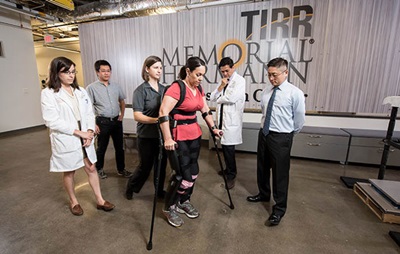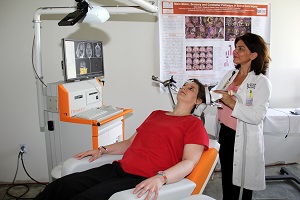The NeuroRecovery Research Center (NRRC) forms the umbrella for seven independent laboratories at TIRR Memorial Hermann that collaborate on basic science studies and clinical trials. Research under way at the NRRC is supported by the National Institutes of Health; Memorial Hermann Foundation; Mission Connect, a project of TIRR Foundation; TIRR Memorial Hermann; and McGovern Medical School at The University of Texas Health Science Center at Houston (UTHealth).
 Center for Wearable Exoskeletons
Center for Wearable Exoskeletons
Researchers at the Center for Wearable Exoskeletons study and develop clinical applications for wearable rehabilitation robotic systems, such as exoskeletons, to facilitate recovery and community reintegration in various patient populations. They also investigate physiological responses to and the underlying mechanisms of exoskeleton systems and interventions.
Current research at the Center focuses on the effects of wearable lower-extremity exoskeletons on gait and mobility in persons with spinal cord injury, stroke and multiple sclerosis. Investigators work in collaboration with other research laboratories in the NeuroRecovery Research Center, the department of Electrical and Computational Engineering at the University of Houston and the School of Physical Therapy at Texas Woman’s University-Houston.
Human-Machine Interface Systems Laboratory
A collaboration with the department of Electrical and Computational Engineering at the University of Houston, the Neural Interfaces Laboratory is home to researchers studying neural interfaces in patient populations to better understand the underlying mechanisms of neural repair and recovery through reverse-translational studies of brain plasticity and brain-machine interaction. Knowledge gained from these studies will be used to develop biorobots and powered wearable exoskeletons in collaboration with other laboratories at the NRRC.
 Neuromodulation Laboratory
Neuromodulation Laboratory
Research under way in the Neuromodulation Laboratory is focused on understanding the effects of noninvasive brain stimulation techniques on recovery from central nervous system disease or injury. Investigators are also developing treatment protocols for noninvasive brain stimulation, with or without adjunctive therapy modalities, to reduce neurologic impairments across populations.
NeuroMyo Engineering for Rehabilitation Laboratory
In the NeuroMyo Engineering for Rehabilitation Lab, investigators are developing and promoting assistive training and rehabilitation devices toward function restoration for patients with spinal cord injury, stroke and other neurological injuries. To understand the neural mechanisms contributing to impairment of human voluntary motion, they record electrical activity from single motor units as well as from whole muscle in neurological injury patients. They are also investigating the effects of different clinical interventions to aid in the design of rehabilitation strategies targeting specific motor unit properties.
Neurorehabilitation Research Laboratory
Researchers in the lab are studying the neurophysiology and pathophysiology of sensory and motor functions at the system level in healthy subjects and in patients with neurological impairments using a variety of stimulation methods – transcranial magnetic stimulation; transcranial direct current stimulation; peripheral electrical, thermal and acoustic stimulation; and BreEStim. Their goal is to develop interventions that facilitate recovery of sensory and motor function after neurological impairments in patients with post-stroke spasticity, neuropathic pain after spinal cord injury and amputation.
Robotics and Rehabilitation Engineering
In the Robotics Laboratory, investigators are focused on the design, manufacture and evaluation of rehabilitation robotic devices for the upper limb. In collaboration with the department of Mechanical Engineering at Rice University, they aim to translate the latest innovations in robotic systems for rehabilitation following neurological injury to clinical practice. Robotic devices that are compatible with magnetic resonance imaging are used to gain insight into the neural basis of injury and recovery. Through the development of novel methods of sensing and control, researchers hope to detect user intent to formulate patient-centric therapies for maximum functional recovery.
UTHealth Motor Recovery Laboratory at TIRR Memorial Hermann
The UTHealth Motor Recovery Laboratory investigates a variety of areas in clinical rehabilitation. Among its many projects are studies of the role of robot-assisted therapy in exercise and health maintenance, mechanical oscillation and plasticity, orthotronic mobility systems and pharmacologic management of spasticity.
Research Highlights
For more information about the NeuroRecovery Research Center (NRRC) and UTHealth PM&R Current Research, visit the UTHealth PM&R Current Research page.